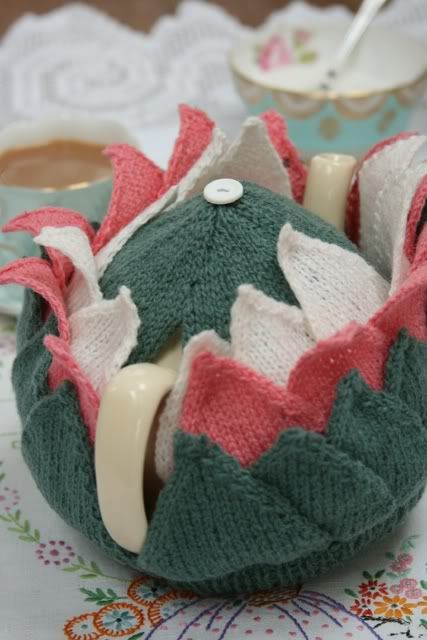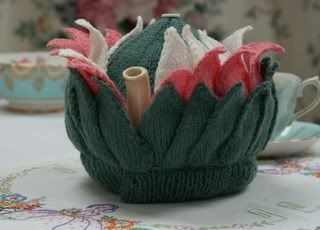At the end of last week I published the latest pattern in the Vintage Gifts to Knit collection which is my lovely retro teapot cosy called Flower-ty Pot.

The cosy is knitted in Jamieson & Smith 2 ply jumper yarn and when experimenting I found that after 45 minutes the tea in the pot was still steaming hot, which has to say something about the insulating qualities of wool. The colours I chose for the flower-ty petals are the accent colours in my slowly proceeding kitchen. I have quite a few pieces of pink glass and green china so hope to pick them out as the kitchen progresses. In the foreground you can see a little embroidered tray doilly that I picked up for 50p at a local jumble sale.

Here's the pot from the other end! Whilst working on the pattern for the cosy I was reminded of George Orwell's famous essay on tea making. Even within my own family there is often heated debates about the right way to make tea. Below is an extract from Orwell's essay, agree or disagree?
A Nice Cup of Tea by George Orwell
Here are my own eleven rules, every one of which I regard as golden:
First of all, one should use Indian or Ceylonese tea. China tea has virtues which are not to be despised nowadays--it is economical, and one can drink it without milk--but there is not much stimulation in it. One does not feel wiser, braver or more optimistic after drinking it. Anyone who has used that comforting phrase 'a nice cup of tea' invariably means Indian tea.
Secondly, tea should be made in small quantities--that is, in a teapot. Tea out of an urn is always tasteless, while army tea, made in a cauldron, tastes of grease and whitewash. The teapot should be made of china or earthenware. Silver or Britannia ware teapots produce inferior tea and enamel pots are worse; though curiously enough a pewter teapot (a rarity nowadays) is not so bad.
Thirdly, the pot should be warmed beforehand. This is better done by placing it on the hob than by the usual method of swilling it out with hot water.
Fourthly, the tea should be strong. For a pot holding a quart, if you are going to fill it nearly to the brim, six heaped teaspoons would be about right. In a time of rationing, this is not an idea that can be realized on every day of the week, but I maintain that one strong cup of tea is better than twenty weak ones. All true tea lovers not only like their tea strong, but like it a little stronger with each year that passes--a fact which is recognized in the extra ration issued to old-age pensioners.
Fifthly, the tea should be put straight into the pot. No strainers, muslin bags or other devices to imprison the tea. In some countries teapots are fitted with little dangling baskets under the spout to catch the stray leaves, which are supposed to be harmful. Actually one can swallow tea-leaves in considerable quantities without ill effect, and if the tea is not loose in the pot it never infuses properly.
Sixthly, one should take the teapot to the kettle and not the other way about. The water should be actually boiling at the moment of impact, which means that one should keep it on the flame while one pours. Some people add that one should only use water that has been freshly brought to the boil, but I have never noticed that it makes any difference.
Seventhly, after making the tea, one should stir it, or better, give the pot a good shake, afterwards allowing the leaves to settle.
Eighthly, one should drink out of a good breakfast cup--that is, the cylindrical type of cup, not the flat, shallow type. The breakfast cup holds more, and with the other kind one's tea is always half cold--before one has well started on it.
Ninthly, one should pour the cream off the milk before using it for tea. Milk that is too creamy always gives tea a sickly taste.
Tenthly, one should pour tea into the cup first. This is one of the most controversial points of all; indeed in every family in Britain there are probably two schools of thought on the subject. The milk-first school can bring forward some fairly strong arguments, but I maintain that my own argument is unanswerable. This is that, by putting the tea in first and stirring as one pours, one can exactly regulate the amount of milk whereas one is liable to put in too much milk if one does it the other way round.
Lastly, tea--unless one is drinking it in the Russian style--should be drunk WITHOUT SUGAR. I know very well that I am in a minority here. But still, how can you call yourself a true tea-lover if you destroy the flavour of your tea by putting sugar in it? It would be equally reasonable to put in pepper or salt. Tea is meant to be bitter, just as beer is meant to be bitter. If you sweeten it, you are no longer tasting the tea, you are merely tasting the sugar; you could make a very similar drink by dissolving sugar in plain hot water. Some people would answer that they don't like tea in itself, that they only drink it in order to be warmed and stimulated, and they need sugar to take the taste away. To those misguided people I would say: Try drinking tea without sugar for, say, a fortnight and it is very unlikely that you will ever want to ruin your tea by sweetening it again. These are not the only controversial points to arise in connexion with tea drinking, but they are sufficient to show how subtilized the whole business has become. There is also the mysterious social etiquette surrounding the teapot (why is it considered vulgar to drink out of your saucer, for instance?) and much might be written about the subsidiary uses of tea leaves, such as telling fortunes, predicting the arrival of visitors, feeding rabbits, healing burns and sweeping the carpet. It is worth paying attention to such details as warming the pot and using water that is really boiling, so as to make quite sure of wringing out of one's ration the twenty good, strong cups of that two ounces, properly handled, ought to represent.
www.george-orwell.orgAll of the works and pictures on george-orwell.org are considered to be in the public domain (copyright protection has expired) and, as such, you may freely use the text of the works in any way you see fit.
I have to agree with George completely on no sugar and my Ruby nan always insisted that you could tell how well bred someone was by whether milk went in before or after the tea!
The Flower-ty pot pattern can be bought via ravelry for £2.50 or via the blog links and until the end of the month I am donating 50% of the sale price to MSF Help for Haiti.

4 comments :
That an amazing tea cozy. I love it!
That is the most gorgeous tea cozy I've ever seen.
What an amazing tea cosy design! I agree with the tea stuff except it should be in a big mug!
Great blog as for me. I'd like to read a bit more concerning that matter. The only thing it would also be great to see on this blog is some pictures of any devices.
John Trider
Cell jammer
Post a Comment